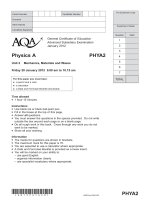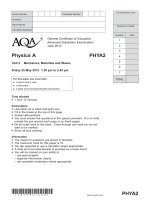AQA PHYA42 QP JUN14
Bạn đang xem bản rút gọn của tài liệu. Xem và tải ngay bản đầy đủ của tài liệu tại đây (775.58 KB, 12 trang )
Centre Number
For Examiner’s Use
Candidate Number
Surname
Other Names
Examiner’s Initials
Candidate Signature
Question
General Certificate of Education
Advanced Level Examination
1
June 2014
2
Mark
3
Physics A
PHYA4/2
Unit 4 Fields and Further Mechanics
Section B
4
TOTAL
Wednesday 11 June 2014 1.30 pm to 3.15 pm
For this paper you must have:
l a calculator
l a ruler
l a Data and Formulae Booklet (enclosed).
Time allowed
l The total time for both sections of this paper is 1 hour 45 minutes.
You are advised to spend approximately one hour on this section.
Instructions
l Use black ink or black ball-point pen.
l Fill in the boxes at the top of this page.
l Answer all questions.
l You must answer the questions in the space provided. Answers written
in margins or on blank pages will not be marked.
l Do all rough work in this book. Cross through any work you do not
want to be marked.
l Show all your working.
Information
l The marks for questions are shown in brackets.
l The maximum mark for this paper is 50.
l You are expected to use a calculator where appropriate.
l A Data and Formulae Booklet is provided as a loose insert.
l You will be marked on your ability to:
– use good English
– organise information clearly
– use specialist vocabulary where appropriate.
(JUN14PHYA4201)
WMP/Jun14/PHYA4/2/E4
PHYA4/2
Do not write
outside the
box
2
Section B
Answer all questions in the spaces provided.
1 (a) (i)
Define gravitational field strength and state whether it is a scalar or vector quantity.
[2 marks]
............................................................................................................................................
............................................................................................................................................
............................................................................................................................................
............................................................................................................................................
1 (a) (ii) A mass m is at a height h above the surface of a planet of mass M and radius R.
The gravitational field strength at height h is g. By considering the gravitational force
acting on mass m, derive an equation from Newton’s law of gravitation to express g in
terms of M, R, h and the gravitational constant G.
[2 marks]
1 (b) (i)
A satellite of mass 2520 kg is at a height of 1.39 × 107 m above the surface of the
Earth. Calculate the gravitational force of the Earth attracting the satellite.
Give your answer to an appropriate number of significant figures.
[3 marks]
force attracting satellite ........................................ N
(02)
WMP/Jun14/PHYA4/2
Do not write
outside the
box
3
1 (b) (ii) The satellite in part (b)(i) is in a circular polar orbit. Show that the satellite would travel
around the Earth three times every 24 hours.
[5 marks]
1 (c)
State and explain one possible use for the satellite travelling in the orbit in part (b)(ii).
[2 marks]
............................................................................................................................................
............................................................................................................................................
............................................................................................................................................
............................................................................................................................................
............................................................................................................................................
............................................................................................................................................
14
Turn over
(03)
ᮣ
WMP/Jun14/PHYA4/2
Do not write
outside the
box
4
2 (a)
Figure 1 shows a negative ion which has a charge of – 3e and is free to move in a
uniform electric field. When the ion is accelerated by the field through a distance of
63 mm parallel to the field lines its kinetic energy increases by 4.0 × 10–16 J.
Figure 1
negative ion
2 (a) (i)
– 3e
uniform
electric
field
State and explain the direction of the electrostatic force on the ion.
[2 marks]
............................................................................................................................................
............................................................................................................................................
............................................................................................................................................
............................................................................................................................................
2 (a) (ii) Calculate the magnitude of the electrostatic force acting on the ion.
[2 marks]
magnitude of electrostatic force ........................................ N
2 (a) (iii) Calculate the electric field strength.
[1 mark]
electric field strength .................................. N C–1
(04)
WMP/Jun14/PHYA4/2
Do not write
outside the
box
5
2 (b)
Figure 2 shows a section of a horizontal copper wire carrying a current of 0.38 A.
A horizontal uniform magnetic field of flux density B is applied at right angles to the
wire in the direction shown in the figure.
Figure 2
95 mm
current 0.38 A
current
uniform magnetic field
2 (b) (i)
State the direction of the magnetic force that acts on the moving electrons in
the wire as a consequence of the current and explain how you arrive at your
answer.
[2 marks]
............................................................................................................................................
............................................................................................................................................
............................................................................................................................................
............................................................................................................................................
............................................................................................................................................
2 (b) (ii) Copper contains 8.4 × 1028 free electrons per cubic metre. The section of wire in
Figure 2 is 95 mm long and its cross-sectional area is 5.1 × 10–6 m2.
Show that there are about 4 × 1022 free electrons in this section of wire.
[1 mark]
2 (b) (iii) With a current of 0.38 A, the average velocity of an electron in the wire is
5.5 × 10–6 m s–1 and the average magnetic force on one electron is 1.4 × 10–25 N.
Calculate the flux density B of the magnetic field.
[2 marks]
flux density ......................................... T
Turn over
(05)
ᮣ
WMP/Jun14/PHYA4/2
10
Do not write
outside the
box
6
3 (a) (i)
Name the two types of potential energy involved when a mass–spring system
performs vertical simple harmonic oscillations.
[1 mark]
............................................................................................................................................
............................................................................................................................................
3 (a) (ii) Describe the energy changes which take place during one complete oscillation of a
vertical mass-spring system, starting when the mass is at its lowest point.
[2 marks]
............................................................................................................................................
............................................................................................................................................
............................................................................................................................................
............................................................................................................................................
............................................................................................................................................
............................................................................................................................................
3 (b)
Figure 3 shows how the total potential energy due to the simple harmonic motion
varies with time when a mass-spring system oscillates vertically.
Figure 3
total
potential
energy
0
0
3 (b) (i)
0.2
0.4
0.6
time / s
0.8
1.0
1.2
State the time period of the simple harmonic oscillations that produces the
energy–time graph shown in Figure 3, explaining how you arrive at your answer.
[2 marks]
............................................................................................................................................
............................................................................................................................................
............................................................................................................................................
............................................................................................................................................
(06)
WMP/Jun14/PHYA4/2
Do not write
outside the
box
7
3 (b) (ii) Sketch a graph on Figure 4 to show how the acceleration of the mass varies with time
over a period of 1.2 s, starting with the mass at the highest point of its oscillations. On
your graph, upwards acceleration should be shown as positive and downwards
acceleration as negative. Values are not required on the acceleration axis.
[2 marks]
Figure 4
acceleration
0
0.2
3 (c) (i)
0.4
0.6
0.8
1.0
1.2
time / s
The mass of the object suspended from the spring in part (b) is 0.35 kg. Calculate the
spring constant of the spring used to obtain Figure 3. State an appropriate unit for
your answer.
[3 marks]
spring constant ...................................... unit ....................................
3 (c) (ii) The maximum kinetic energy of the oscillating object is 2.0 × 10–2 J. Show that the
amplitude of the oscillations of the object is about 40 mm.
[4 marks]
14
Turn over
(07)
ᮣ
WMP/Jun14/PHYA4/2
Do not write
outside the
box
8
4 (a)
When an uncharged capacitor is charged by a constant current of 4.5 μA for 60 s the
pd across it becomes 4.4 V.
4 (a) (i)
Calculate the capacitance of the capacitor.
[3 marks]
capacitance ......................................... F
4 (a) (ii) The capacitor is charged using the circuit shown in Figure 5. The battery emf is 6.0 V
and its internal resistance is negligible. In order to keep the current constant at 4.5 μA,
the resistance of the variable resistor R is decreased steadily as the charge on the
capacitor increases.
Figure 5
A
R
C
Calculate the resistance of R when the uncharged capacitor has been charging
for 30 s.
[3 marks]
resistance ........................................ Ω
(08)
WMP/Jun14/PHYA4/2
Do not write
outside the
box
9
4 (b)
The circuit in Figure 6 contains a cell, an uncharged capacitor, a fixed resistor and a
two-way switch.
Figure 6
A
B
1
2
PQ
The switch is moved to position 1 until the capacitor is fully charged. The switch is then
moved to position 2.
Describe what happens in this circuit after the switch is moved to position 1, and after it
has been moved to position 2. In your answer you should refer to:
l
the direction in which electrons flow in the circuit, and how the flow of electrons
changes with time,
l
how the potential differences across the resistor and the capacitor change with
time,
l
the energy changes which take place in the circuit.
The terminals of the cell are labelled A and B and the capacitor plates are labelled P
and Q so that you can refer to them in your answer.
The quality of your written communication will be assessed in your answer.
[6 marks]
............................................................................................................................................
............................................................................................................................................
............................................................................................................................................
............................................................................................................................................
............................................................................................................................................
............................................................................................................................................
............................................................................................................................................
............................................................................................................................................
Turn over
(09)
ᮣ
WMP/Jun14/PHYA4/2
Do not write
outside the
box
10
............................................................................................................................................
............................................................................................................................................
............................................................................................................................................
............................................................................................................................................
............................................................................................................................................
............................................................................................................................................
............................................................................................................................................
............................................................................................................................................
............................................................................................................................................
............................................................................................................................................
............................................................................................................................................
............................................................................................................................................
............................................................................................................................................
............................................................................................................................................
............................................................................................................................................
............................................................................................................................................
............................................................................................................................................
............................................................................................................................................
............................................................................................................................................
............................................................................................................................................
............................................................................................................................................
............................................................................................................................................
............................................................................................................................................
12
END OF QUESTIONS
(10)
WMP/Jun14/PHYA4/2
11
There are no questions printed on this page
DO NOT WRITE ON THIS PAGE
ANSWER IN THE SPACES PROVIDED
(11)
WMP/Jun14/PHYA4/2
12
There are no questions printed on this page
DO NOT WRITE ON THIS PAGE
ANSWER IN THE SPACES PROVIDED
Copyright © 2014 AQA and its licensors. All rights reserved.
(12)
WMP/Jun14/PHYA4/2









